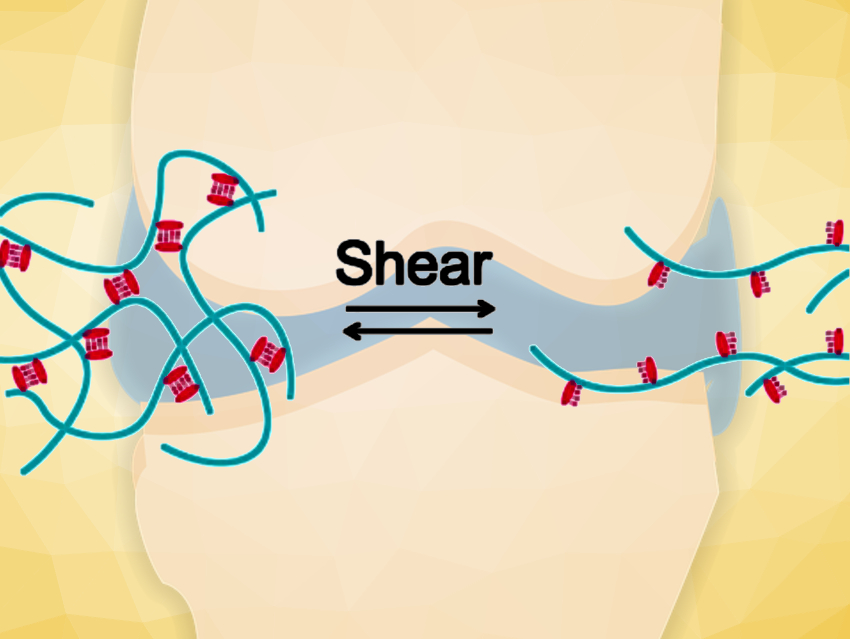Dynamic molecular networks can give materials new, more responsive qualities. Syni Varghese, Duke University, Durham, NC, USA, and colleagues have built on this idea by introducing a supramolecular network to hyaluronic acid, a polymer found throughout the body, making it more dynamic and self-healing.
In the body, hyaluronic acid has water-retaining and cartilage-preserving properties. The team’s work has also made it a viable injectable lubricant for injured joints.
High or Low Viscosity?
Hyaluronic acid is known for, e.g., wrinkle-filling and cartilage-preserving properties. These are due to the fact that it is a glucosaminoglycan, a natural polymer made of repeating units of a dimer of glucuronic acid and N-acetylglucosamine. The polymer binds and retains water molecules, is water-soluble, and interacts readily with many surfaces.
Its biocompatibility and its vital role in cartilage tissue has led to applications as a lubricant and protecting substance for damaged joints. For example, patients with osteoarthritis suffer from pain caused by lost cartilage and bones rubbing against each other. Treatment with hyaluronic acid can be beneficial in these cases, but an ideal form of this substance that is easy to apply, safe, and long-lasting, has not yet been found.
In the body, where it is abundant in the extracellular matrix, hyaluronic acid is present in different molecular sizes with different degrees of cross-linking. Solutions of the low-molecular-weight, low viscosity version are injectable but vanish from their target site within a few hours. In contrast, viscous forms, which have a higher molecular weight and are stabilized by cross-linking, are longer-lasting, but they are more difficult to handle and do not spread well in the joint.
Dynamic Solution
With this in mind, the researchers opted for a compromise and created a dynamic, shear-thinning version of hyaluronic acid. Shear-thinning fluids behave as viscous gels when at rest but change into flowable liquids under shear stress. Many viscous products have this quality. Ketchup, for example, only runs runs smoothly out of a bottle when it has been vigorously shaken.
To give the hyaluronic acid shear-thinning properties, the team inserted a flexible, supramolecular cross-linker. This molecule consisted of two hexacarbonyl chains connected by a ureido unit and carrying a ureidopyrimidone functional group at one end. Ureidopyrimidone groups can form four hydrogen bonds, ensuring rapid dimerization under physiological conditions. At the other end, the linker carried an amino function, attaching it to the glucuronic acid monomer by forming an amide bond. The researchers reported that after the reaction had ended, 24 % of the glucuronic acid units in the glucosaminoglycan carried the linker, an important prerequisite for creating a dynamic noncovalent network.
The team’s modified hyaluronic acid did indeed reveal new dynamic qualities. At rest and under physiological conditions, a 10 % solution appeared as a viscous gel. However, squeezing converted it to a liquid, as the supramolecular cross-links broke down under shear stress. This meant the researchers could draw the solution up in a syringe and extrude it, but after extrusion, the hydrogen bonds in the linker re-formed, and the solution returned to gel form. The gel also showed self-healing qualities: when separate gels were brought together, they joined seamlessly together.
Long-Lasting, Self-Healing Lubricant
Encouraged by its shear-thinning and self-healing effects, the researchers tested the modified hyaluronic acid as a joint lubricant. First, they injected it into the knee joints of healthy rats and found it remained in place for several days. Then, using minimally invasive surgery, they injured the knee joints of live rats and observed the outcome after treating them with either the modified or the unmodified version of the hyaluronic acid.
After a few weeks of repeated injections, only the rats treated with the modified version had a satisfactory prognosis. Although they still suffered from the partly healed injury, they did not develop additional osteoarthritis. In contrast, the control rats suffered additional severe cartilage loss as a result of the injury.
The team concluded that the supramolecular cross-links made the hyaluronic acid stable enough to be retained in the joints. At the same time, its shear-thinning properties also enabled it to spread out within the joint where it exerted its cell-protecting and lubricating effects. In vitro experiments also suggested that the cross-linked hyaluronic acid was a scavenger of free radicals (probably through the ureidopyrimidone unit in the linker) and was more resistant to enzymatic degradation than the unmodified version.
The researchers recommend their dynamic cross-linking approach as a feasible option to give biomaterials self-healing properties, improve their viscoelasticity, and create efficient biolubricants.
- Self‐Healing of Hyaluronic Acid to Improve In Vivo Retention and Function,
Anna Gilpin, Yuze Zeng, Jiaul Hoque, Ji Hyun Ryu, Yong Yang, Stefan Zauscher, William Eward, Shyni Varghese,
Adv. Healthcare Mater. 2021.
https://doi.org/10.1002/adhm.202100777



